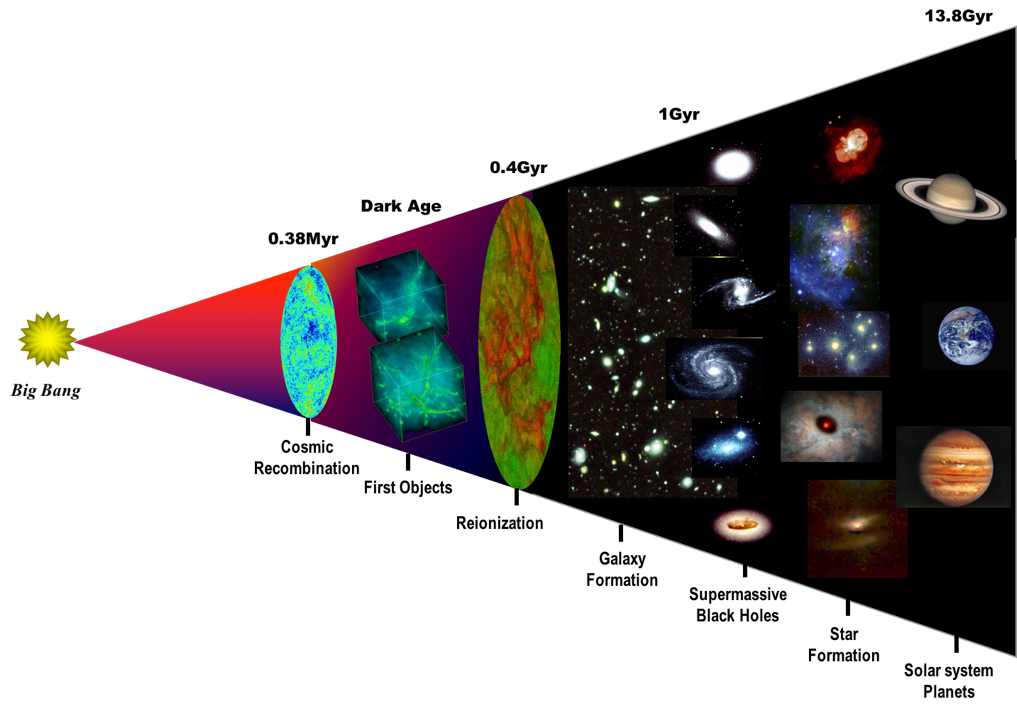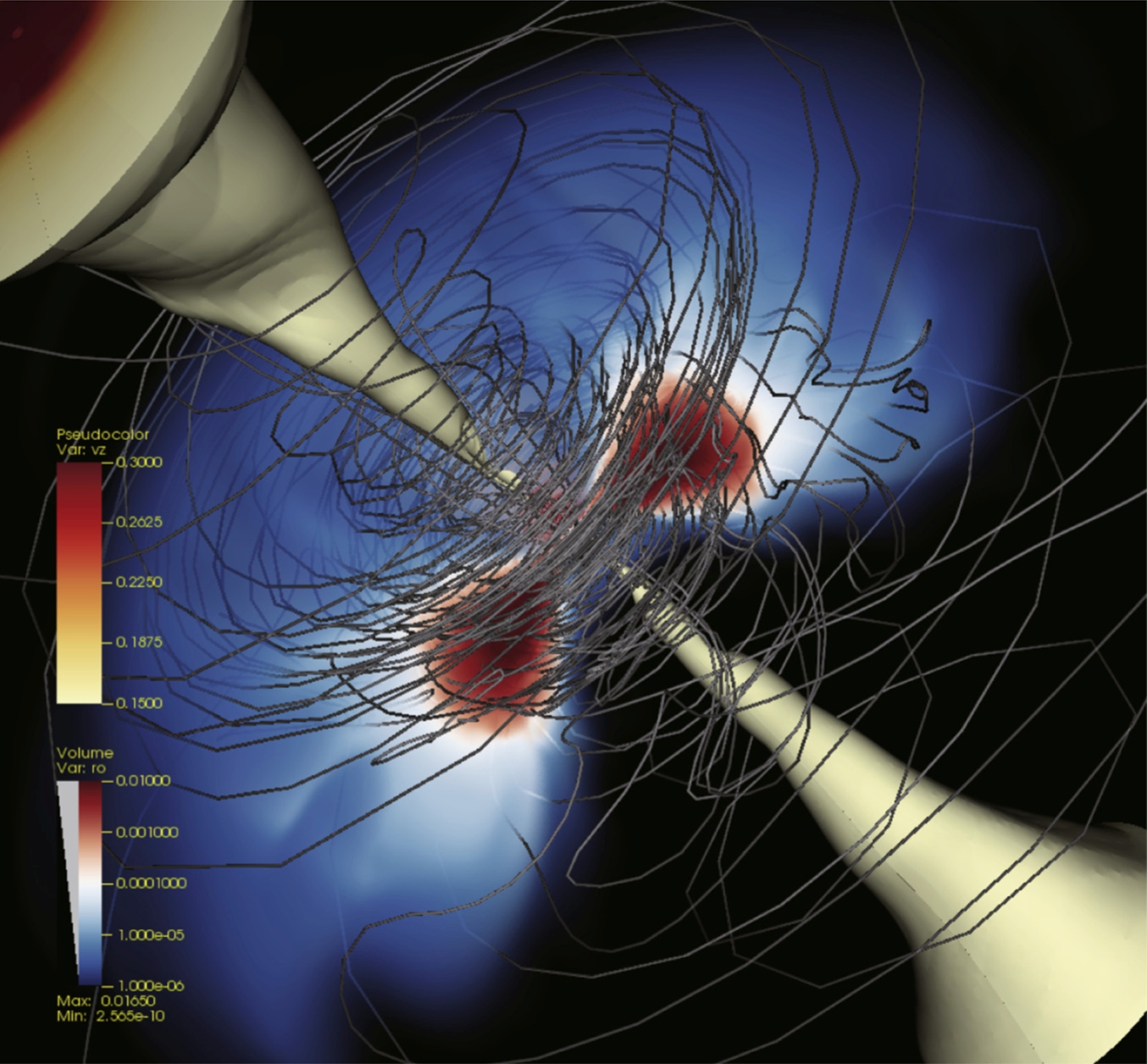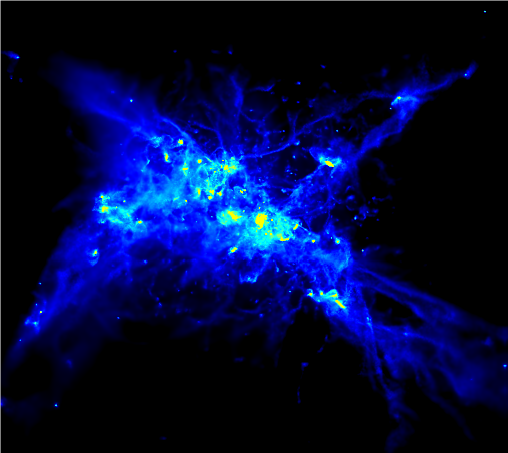Chief
 |
OHSUGA Ken, Professor
He graduated from the University of Tsukuba, in 2001 with a Ph.D (Sciences). He was a JSPS Research Fellow (Kyoto University/Paris Observatory) in 2001, a Research Associate at Rikkyo University in 2004, a RIKEN Basic Science Fellow in 2007, and an Assistant Professor at NAOJ in 2008 before assuming his current position in 2018. He specializes in theoretical astrophysics. He studies black hole accretion flows, jets, and the formation process of supermassive black holes using radiation magnetohydrodynamics simulations. |
Outline
The universe is believed to have been born 13.8 billion years ago with the Big Bang. The universe continued to expand, gradually decreasing in temperature and density. The first hydrogen atoms appeared 3.8 million years after the big bang, in the epoch of recombination. The temperature of the universe then was 3000 K, no stars or galaxies existed, only small density fluctuations with amplitudes at the 0.01% level.
Recently, many young galaxies existing in the universe already 600 million years since the Big Bang have been discovered. This tells us that the universe has undergone a major transformation between 3.8 and 600 million years after its birth, a transformation generally linked to galaxy formation. The processes, however, by which galaxies are born is still shrouded in mystery.
Since the formation of the first galaxies, the universe continued to expand and evolve, and the galaxies clustered to form the large-scale structure of the cosmos. The formation of galaxies and the evolution of the universe is believed to be underpinned by the ubiquitous existence of dark matter.
 Figure 1 Chronology of the Universe
Figure 1 Chronology of the Universe
Research topics
In Astrophysics, we seek to understand, using fundamental laws of physics, the birth of the first stars and galaxies, the light they emit, the formation and evolution of galaxies and galaxy clusters, the formation and evolution of black holes and active galactic nuclei, and the formation of stars and planets. We pursue these aims by accurately solving radiative transfer equations and relativistic radiation-hydrodynamic equations and thereby realistically simulating the interaction between radiation and matter, and the multi-constituent, multi-bodied nature of the formation and evolution of astrophysical objects. We frequently begin a project by making analytical advances and numerical estimates of the important physics involved in the problem, before launching large scale numerical simulations on supercomputers hosted at the Center for Computational Sciences.
Achievements to date
Figure 2 depicts an accretion disc around a black hole and a jet emanating from the black hole’s ergosphere as calculated by general-relativistic radiation-magnetohydrodynamic simulations. Matter attracted by the formidable gravitational force of the black hole forms an accretion disc and, little by little, gets sucked into the black hole. In the accretion disc, gravitational energy is released, and an enormous swathe of photons is emitted. The force of the photons is so strong that it can lift off material from the accretion disc in the form of jets that can escape the gravity of the black hole.
 Figure 2 Accretion disc and jet around a black hole
Figure 2 Accretion disc and jet around a black hole
Figure 3 shows the formation of the first galaxies in the early universe, as calculated with state-of-the-art cosmological hydrodynamic simulations. In the era of galaxy formation, gas efficiently accretes along cosmic filaments onto galaxies, triggering massive bursts of star-formation in the galaxies. Those stars eventually explode in supernovae, which drives out much of the gas in the galaxies, rapidly quenching star-formation. The star-formation history in the early universe is, thus, very intermittent; it is a self-regulating cycle of bursts of star-formation and quiescence.
 Figure 3 Simulation of cosmological galaxy formation simulation in the early universe
Figure 3 Simulation of cosmological galaxy formation simulation in the early universe
Web sites
Theoretical Astrophysics Group
FIRST (Japanese)
(Update: Dec. 18, 2019)
